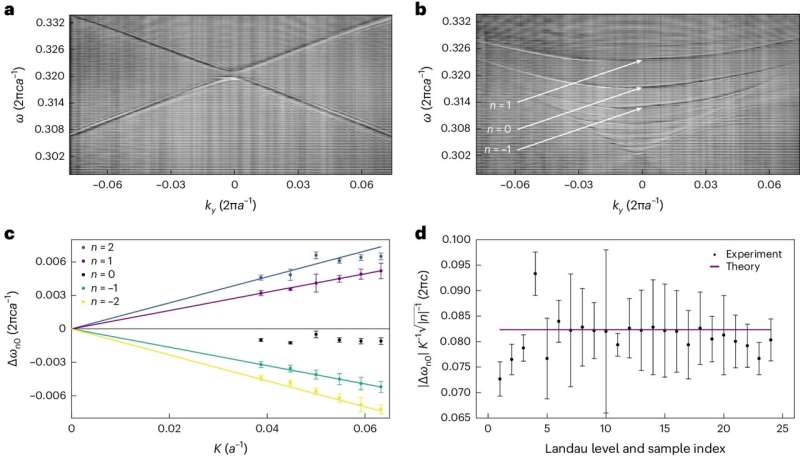This article has been reviewed according to Science X's editorial process and policies. Editors have highlighted the following attributes while ensuring the content's credibility:
fact-checked
peer-reviewed publication
trusted source
proofread
Making light 'feel' a magnetic field like an electron would

Unlike electrons, particles of light are uncharged, so they do not respond to magnetic fields. Despite this, researchers have now experimentally made light effectively "feel" a magnetic field within a complicated structure called a photonic crystal, which is made of silicon and glass.
Within the crystal, the light spins in circles and the researchers observed, for the first time, that it forms discrete energy bands called Landau levels, which parallels a well-known phenomenon seen in electrons.
This finding could point to new ways to increase the interaction of light with matter, an advance that has the potential to improve photonic technologies, like very small lasers.
This work, led by researchers at Penn State, was based on an earlier theoretical prediction by team members Penn State Professor of Physics Mikael Rechtsman, Penn State graduate student Jonathan Guglielmon and Columbia University mathematician Michael Weinstein.
A paper describing the experiments was published April 23 in the journal Nature Photonics alongside another paper by a separate group of researchers in the Netherlands, led by Ewold Verhagen, who independently observed the same phenomenon.
"For charged particles like electrons, there is a lot of interesting physics that results from their interactions with magnetic fields," said Rechtsman, the leader of the research team. "Because of this, there has a been an interest in emulating this physics for photons, which are not charged and so do not respond to magnetic fields."
When electrons confined to a two-dimensional surface are exposed to a strong magnetic field they move in circular, or "cyclotron," orbits. The motion of these orbits becomes quantized—the electrons become constrained to certain discrete energies, which are called Landau levels.
"Landau levels are sort of akin to the energy levels of electron orbitals around the nucleus of an atom," Rechtsman said. "In an atom, the energy levels result from the attraction of negatively charged electrons to the positively charged nucleus, whereas Landau levels result from the interaction of the electrons with a magnetic field. We employed a method of emulating a magnetic field—called a pseudomagnetic field—for light by precisely manipulating the structure of a photonic crystal."
The research team creates these crystals in tiny slabs of silicon, similar to what is used to make computer chips, at the Nanofabrication Laboratory within the Materials Research Institute at Penn State. They create a honeycomb-like lattice of holes within the silicon slab, which is only 1/1000th the thickness of a human hair.
The researchers shine laser light into the crystal-containing slab, and the lattice pattern causes some of the light to bounce around within the crystal. The team can then measure the spectrum of the light when it exits the crystal. To mimic the effects of a magnetic field, the researchers add a "strain" to the pattern of the lattice.
"For the unstrained lattice, we fabricated a honeycomb structure out of nanoscale triangular holes that repeats throughout space in a two-dimensional pattern," Rechtsman explained. "To add the strain, we made another slab, but deformed the pattern. The new pattern looks as if we pulled up on the two sides, while pulling down on the bottom side."
When the researchers shine the laser into the unstrained lattice, the light spreads out evenly in the crystal. In the strained lattice, the light instead moves in circles and the energy spectrum of the light changes, forming discrete bands just like Landau levels. Unlike Landau levels in electrons, the energy bands are not flat. Instead, they are curved, which the researchers said results from the curved pattern in the strained crystal.
"The curved nature of the bands is known as dispersion," Rechtsman said. "To try to mitigate the dispersion, we added an additional strain to the pattern. This added strain, which acts as a pseudo-electric potential, counteracts the dispersion, giving us flat-band Landau levels just like those from electrons."
The flat bands represent a concentration of photons at certain discrete energies, providing an avenue to increase the interaction of light with matter.
"There's a bunch of applications where increasing the interaction of light and matter can improve their function," Rechtsman said. "When you have flat bands, that means that the light is sticking around in one place for longer, which means that whatever you're trying to do with the light, you can do it more efficiently. Right now, we're looking into whether we can use this design for more efficient lasers on photonic chips."
More information: Maria Barsukova et al, Direct observation of Landau levels in silicon photonic crystals, Nature Photonics (2024). DOI: 10.1038/s41566-024-01425-y
Journal information: Nature Photonics
Provided by Pennsylvania State University





















